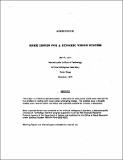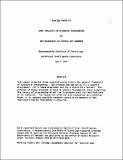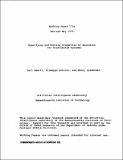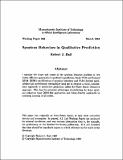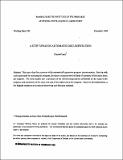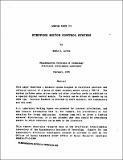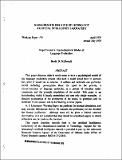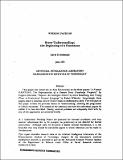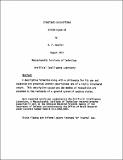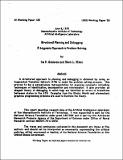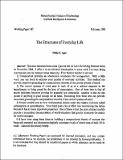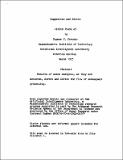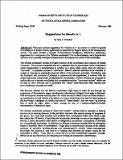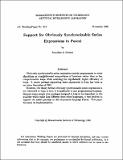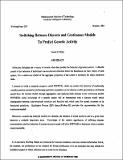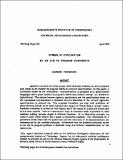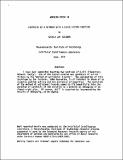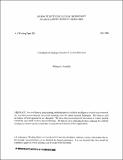Browsing AI Working Papers (1971 - 1995) by Title
Now showing items 226-245 of 291
-
Some Issues for a Dynamic Vision System
(MIT Artificial Intelligence Laboratory, 1974-12)This paper is a thesis-proposal-proposal: a discussion of some issues which seem relevant to the problem of dealing with visual scenes undergoing change. The problem area is broadly stated, some relevant points are noted, ... -
Some Projects in Automatic Programming
(MIT Artificial Intelligence Laboratory, 1974-04)This paper proposes three research topics within the general framework of Automatic Programming. The projects are designing (1) a student programmer, (2) a robot programmer and (3) a physicist's helper. The purpose of these ... -
Specifying and Proving Properties of Guardians for Distributed Systems
(MIT Artificial Intelligence Laboratory, 1979-05)In a distributed system where many processors are connected by a network and communicate using message passing, many users can be allowed to access the same facilities. A public utility is usually an expensive or limited ... -
Spurious Behaviors in Qualitative Prediction
(MIT Artificial Intelligence Laboratory, 1988-03)I examine the scope and causes of the spurious behavior problem in two widely different approaches to qualitative prediction, Sacks' PLR and Kuipers' QSIM. QSIM's proliferation of spurious behaviors and PLR's limited ... -
A Step Towards Automatic Documentation
(MIT Artificial Intelligence Laboratory, 1980-12)This paper describes a system which automatically generates program documentation. Starting with a plan generated by analyzing the program, the system computes several kinds of summary information about the program. The ... -
Stepping Motor Control System
(MIT Artificial Intelligence Laboratory, 1979-02)This paper describes a hardware system designed to facilitate position and velocity control of a group of eight stepping motors using a PDP-11. The system includes motor driver cards and other interface cards in addition ... -
Steps Toward a Psycholinguistic Model of Language Production
(MIT Artificial Intelligence Laboratory, 1979-04)This paper discusses what it would mean to have a psychological model of the language production process: what such a model would have to account for, what it would use as evidence. It outlines and motivates one particular ... -
A Stored Picture Hacking Facility
(MIT Artificial Intelligence Laboratory, 1972-06)A short description of LISP functions that have been written for use with the stored picture facility. These functions allow one to display an image of a stored scene on the 340 scope, and produce graphs and histograms of ... -
Story Understanding: the Beginning of a Consensus
(MIT Artificial Intelligence Laboratory, 1978-06)This paper is written for an Area Examination on the three papers: "A Framed PAINTING: The Representation of a Common Sense Knowledge Fragment" by Eugene Charniak, "Reporter: An Intelligent Noticer" by Steve Rosenberg, and ... -
Structured Descriptions
(MIT Artificial Intelligence Laboratory, 1973-08)A descriptive formalism along with a philosophy for its use and expansion are presented wherein descriptions are of a highly structured nature. This descriptive system and the method of recognition are extended to the ... -
Structured Planning and Debugging: A Linguistic Approach to Problem Solving
(MIT Artificial Intelligence Laboratory, 1976-06-08)A structured approach to planning and debugging is obtained by using an Augmented Transition Network (ATN) to model the problem solving process. This proves to be a perspicuous representation for planning concepts including ... -
The Structures of Everyday Life
(MIT Artificial Intelligence Laboratory, 1985-02)This note descends from a talk I gave at the AI Lab's Revolving Seminar series in November 1984. I offer it as an informal introduction to some work I've been doing over the last year on common sense reasoning. Four themes ... -
Suggestions and Advice
(MIT Artificial Intelligence Laboratory, 1973-03)Results of scene analysis, as they are achieved, direct and advise the flow of subsequent processing. -
Suggestions for Genetic A.I.
(MIT Artificial Intelligence Laboratory, 1980-02)This paper presents suggestions for "Genetic A.I.": an attempt to model the genesis of intelligence in human infants, particularly as described by Piaget's theory of the Sensorimotor period. The paper includes a synopsis ... -
Summary of Selected Vision Topics
(MIT Artificial Intelligence Laboratory, 1972-07)This is an introduction to some of the MIT AI vision work of the last few years. The topics discussed are 1) Waltz's work on line drawing semantics, 2) heterarchy, 3) the ancient learning business and 4) copying scenes. ... -
Support for Obviously Synchonizable Series Expressions in Pascal
(MIT Artificial Intelligence Laboratory, 1988-11)Obviously synchronizable series expressions enable programmers to write algorithms as straightforward compositions of functions rather than as less comprehensible loops while retaining the significantly higher efficiency ... -
Switching Between Discrete and Continuous Models To Predict Genetic Activity
(MIT Artificial Intelligence Laboratory, 1983-10)Molecular biologists use a variety of models when they predict the behavior of genetic systems. A discrete model of the behavior of individual macromolecular elements forms the foundation for their theory of each system. ... -
Symbol IC-Evaluation as an Aid to Program Synthesis
(MIT Artificial Intelligence Laboratory, 1976-04)Symbolic-evaluation is the process which abstractly evaluates an actor program and checks to see whether the program fulfills its contract (specification). In this paper, a formalism based on the conceptual representation ... -
Synthesis of a Network with a Given System Function
(MIT Artificial Intelligence Laboratory, 1974-06)I have just completed teaching two sections of 6.011 (Elementary Network Theory). One of the topics covered was synthesis of active filters by the "method of unilateral 2-ports". The explanation of this technique by the ... -
A Synthesis of Language Ideas for AI Control Structures
(MIT Artificial Intelligence Laboratory, 1980-07)Two well known programming methodologies for artificial intelligence research are compared, the so-called pattern-directed invocation languages and the object-oriented languages. The features and limitations of both ...

